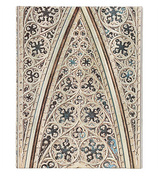Gaudí pioneered a special mosaic design technique called Trencar that is still in vogue and used by a lot of artists today. Trencar, equivalent for “to break” in Catalan, creates mosaic forms and shapes by putting together broken ceramic tiles, plates and cups. It was first used by Gaudí, for decorating the Fincas Güell, the estate of his patron, Eusebi Güell.
- Hard Cover
- 144 pages, Lined
- Measures approximately 7"W x 9"H x .9"D
- Binding - Smyth Sewn
- Satin Ribbon Page Marker
- Wrap Closure
- 100% recycled binder boards
- Decorative printed cover paper
- FSC-certified text paper
- Threaded stitching and glue, as needed
- Acid-free sustainable forest paper
About This Design
- Original Art: A section of a mosaic sun on the ceiling of Park Güell's Hypostyle Room
- Era: Modernism
- Region: Barcelona, Spain
Antoni Gaudí (1852–1926), a Spanish architect from Catalonia, was one of the greatest pioneers of 19th-century architecture. Gaudí’s works have a highly individualized style, defined by his unique compositions, organic shapes and kaleidoscopic designs. They transcend not only mainstream Modernism, but traditional art forms.
Perhaps Gaudí’s most-loved contribution to his city of Barcelona is Park Güell, a vibrant garden filled with his art. Reproduced here is a section of a mosaic sun on the ceiling of the park’s Hypostyle Room, alongside the abstract lines from his chimney pots at the Casa Milà building.
Gaudí’s last work of civic architecture, Casa Milà (also known as La Pedrera) represented a break with the conventions of his day, designed as a totally undulating building with a beating heart like a living being. Gaudí’s fascination with the geometry of nature stemmed from his deep religious devotion, seeing the organic lines as a form of divine creation. With this design, we celebrate Gaudí’s vision and the sense of heaven on earth he created for us all to enjoy.








